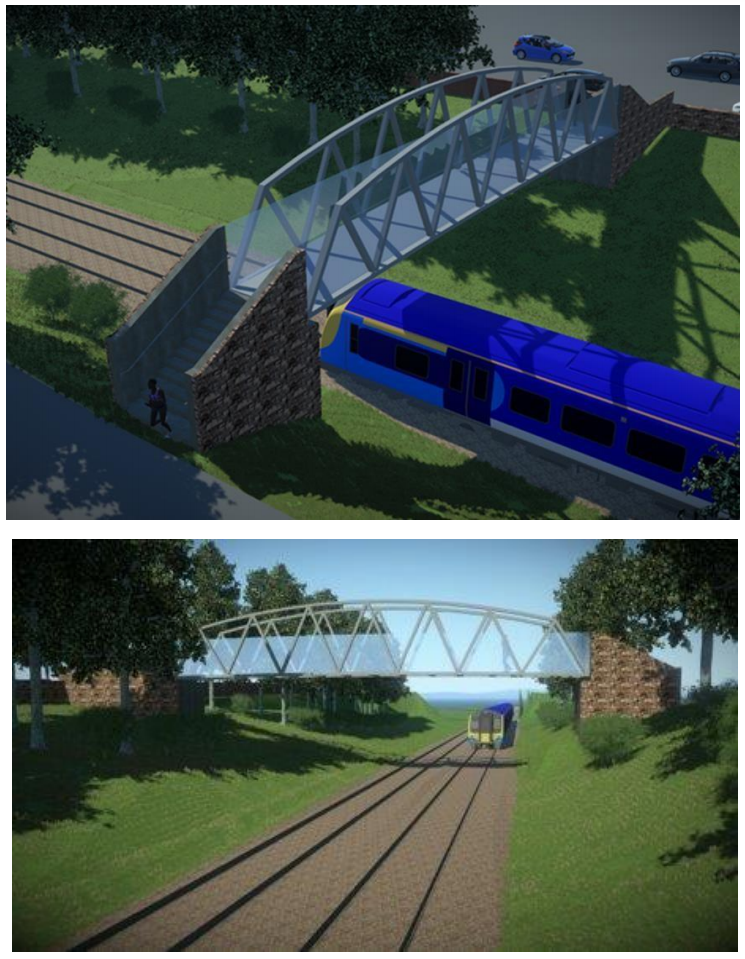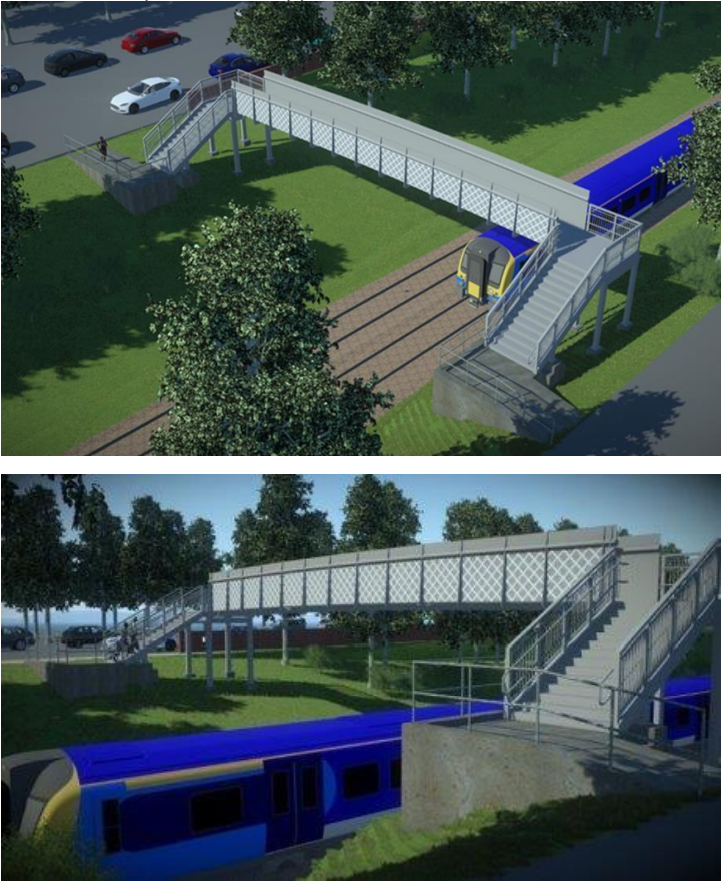The East Kilbride line electrification project means our dear footbridge is likely to come down next year (although there is at least one proposal on how to keep it below). Network Rail have sent letters to residents within 500m of the bridge asking their opinion on three suggested replacements. They want a simple A, B or C vote, and the return envelopes are individually numbered, presumably so they can ignore comments from anyone else. Before you return yours, we include some thoughts on the proposals, notably from Society committee member Fiona MacKinnon. There are plenty more on social media. And if you haven’t had a letter, don’t let that stop you commenting anyway; Network Rail’s contact details are here. As the phone number is their 24hr national helpline, you may be better with the email address.
Email: EKEnhancements@networkrail.co.uk
Web: https://scotlandsrailway.com/projects/east-kilbride-enhancements
Contact Number: 03457 11 41 41
Their proposals can be downloaded here but are reproduced below.
Bridge A
Description: a bespoke design with the parapet height forming a curved feature with a high metal rail on top and lattice frame overlain on toughened glass to achieve a solid but visually open parapet.

Bridge B
Description: a bespoke design which uses metal “fins” of graduating height to interest to the structure. The uprights are attached to toughened glass to achieve a solid but visually open parapet.

Bridge C
Description: this bridge would be a modified standard bridge design which uses metal latticework of a contrasting colour to reflect the heritage of the previous footbridge, soften appearance of the solid parapet and add interest. The solid parapets over the electrified line become open at each approach.

They also comment:
Electrified overhead lines powering the railway carry electricity 100 times greater than in the home and unfortunately, we have had incidents in the past where people have suffered electric shocks after dropping or dangling objects over the sides of bridges.
There are some railway bridges along the route that don’t provide us with the required clearance for electrification standards, the footbridge in Strathbungo being one of them. This means that once we electrify the line there will not be a suitable barrier between the electric current passing through the power cables suspended above the railway and the people using the footbridge, meaning the current bridge needs to be replaced with a new bridge which can accommodate the newly electrified railway.
We appreciate the value placed on this footbridge and how well it is used, and believe the community in Strathbungo should be involved in the process of selecting a suitable replacement bridge.
FAQs
Can Network Rail lower the track or height raise the current footbridge to retain it?
Both these options would require additional foundational and strengthening support with significantly higher parapets added to the structure. ln addition to being the most costly solutions, these options would change the appearance of the bridge entirely.
When will work commence?
Summer 2022 is being proposed for the work on this footbridge, however this date is subject to change.
What will happen to the current footbridge once removed?
We can work with communities on re-homing the footbridge to a charity or museum. Communities also have the option to work with local councils on re-homing structures in a desired location.
Would Network Rail remove the footbridge and not replace?
There is an accessible bridge alternative on Nithsdale Road approx 50 metres away, however we are aware of the importance of this bridge and how frequently it’s used by the community and we do not propose removing the existing bridge without a replacement.
Why did Network Rail refurbish the footbridge in 2019 for it then to be replaced?
Essential repair work was carried out on the footbridge in early 2019 in order for it to remain open. At this stage there was no formal commitment to carry out this electrification project.
This is first time we are undertaking an initiative of this kind, and believe it is a great way to involve the community of Strathbungo in the project.
Responses
It may not be a simple matter of a vote. Each design has its flaws. Fiona summarises many of these.
Before individual consideration of the proposals, it must be noted that the images provided to make a decision are not of high enough quality and lack so much information that it is impossible to correctly understand detail or scale. Are the images even to scale?
There is no representation of the electrified cable infrastructure which would help to understand the impact it will have and the way it will influence the new bridge and setting.
Bridge A
There is an appeal about a bridge that echoes the present historic listed structure with an elliptical curve on the top rail and angled bars across the sides.
There is a failure of design in having the safety glass only rise to an arbitrary point which cuts across the structure. In the image it looks like the glass is not capped on top but in reality, there would probably be a metal strengthening and holding structure across the top edge of the glass which would cut across the design and radically alter the look and feel of the bridge.
The use of glass offers the user of the bridge the chance to see the line and moving trains easily. However, there is a question on how that glass would look after a relatively short time. It risks becoming graffitied, dirty and unattractive, obscuring any view. A management plan needs to be set in place.
The stairs up to the bridge are higher than the present steps and their design has serious flaws. The staircase has high brick or stone sides that produces a dark space, making it difficult to see the steps.
The staircase also creates an issue of personal safety as the solid sides would hide anyone until you are right in front of the steps. The height of the steps means you would not be able to see anyone on the other side of the bridge until you have committed to walking across.
There appears to be a single flight of steps. They would be easier to navigate if the steps were broken by a landing.
The raised bridge structure looks much longer than the present bridge. The span is much wider and this could be the reason for such steep steps.
Such heavy and dark structures would be very dominant in Moray Place and Regent’s Park Square which are in the Strathbungo Conservation Area. There is nothing about their design that is sympathetic to the listed buildings and instead the structure would take away from the important historic streetscape.
There is no indication how the new structures would meet with the present fence and pavement on Moray Place or with the present historic stone wall on Darnley Road. On some images the wall is present but the fence does not appear in any of the images.
Bridge B
The design is a radical change from the present historic listed bridge. There is value in taking the opportunity to add a contemporary design to the historic streetscape. The design allows for the glass to be an integral part of the structure rather than a safety addition as in Bridge A.
In the image for this option a human figure has been added to the bridge. They are half the height of the sides of the structure which would mean those sides would potentially be 3.4 meters high. Is this correct or a failure of the image? That height would mean Bridge B being much more visible from a distance and from within the houses all around.
How the bridge and steps meet the streets and present wall and railings at either side is visually different in this image but not resolved in terms of how it would look and feel. Far more of the wall seems to have been removed, to the point of leaving open access from Darnley Road. This is presumably an error in the rendition.
All the issues with a steep, dark and solid sided flight of steps are identical to Bridge A. Personal safety, ease of use and a negative effect on the historic streetscape.
Bridge C
This seems a retrograde step in design terms. It would not contribute to the setting and offers no way to see the trains which has been a feature of the Strathbungo Footbridge since installation. Has it been included to make the other options seem better ?
The steps offer even more danger for personal safety as you would have no idea who was on the bridge before you climbed the whole flight and turned the corner. The open sides on the steps do offer light and visibility, so why do the other options not have this ?
The treatment of the meeting between the street and the bridge lacks any detail, again offering apparently clear access onto the line. This is not going to be the reality on the ground, so the image is woefully inadequate.
This option seems to have a ramped access and there seems no clear reason why it is present on this option but not on the others.
Conclusion
The images are inadequate for a proper and informed decision to be made. There is no detail or scale and much of the infrastructure is missing.
The designs of the bridges are sketchy but more seriously, are not clearly set in the streetscape of Strathbungo and indicate little or no interest in engaging with the historic environment or how people will be able to use a new footbridge.
Other comments
Lots of comments about the steps up. There is certainly sufficient space for a landing on the Darnley Road side. A gutter ramp at the side of the steps would help pushing bikes, and possibly pushchairs, up the steps.
Why can’t Bridge C have glass sides, and why does that design require the offset ramps when the others don’t? Glass sides might offset the problem with not being able to see who lurks on the bridge until it is too late.
There is also the issue of accessibility, although ramps that meet standards for access would be of enormous size and length, and Network Rail argue the Nithsdale Road bridge is a near enough alternative. Mind you the ramp up that pavement is pretty steep already…
Here’s an alternative idea that retains the existing bridge (Option D?). Why would this be more expensive than a new one?
There are many more comments on Facebook and Twitter.
Strathbungo Society on Facebook
Shawlands & Strathbungo Community Group
Twitter (Paul Sweeney)
So what do you think? Bear in mind that, if you want Network Rail to take notice, you need to send your ideas to them as well as us!









 #b
#b














Bridge B the best option.
bridge B